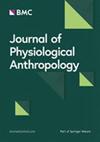Age-related changes in the activation timing of postural muscles to the prime mover muscle for bilateral arm flexion during standing
IF 3.1
4区 医学
Q1 Social Sciences
引用次数: 0
Abstract
We aimed to obtain the standard values of age-related changes in the activation timing of postural muscles to the prime mover muscle (anterior deltoid [AD]) for bilateral arm flexion during standing. The study participants were 276 children (aged 3–14 years) and 32 adults (aged 20–26 years). In response to a visual stimulus, participants raised both arms from a fully extended position as quickly as possible, stopped their arms voluntarily at a horizontal level at the shoulder, and maintained that position for 2 s. Ten test trials were performed. By using surface electromyography, the duration from the burst onset of the postural muscles to that of AD was measured as the starting time of the postural muscles (rectus abdominis [RA], erector spinae [ES], rectus femoris [RF], biceps femoris [BF], tibialis anterior [TA], gastrocnemius medialis [GcM], and soleus [SOL]). The starting time was presented as a negative value when the burst onset of the postural muscles preceded that of AD, which was defined as the preceding activation. A positive value for the starting time was defined as delayed activation. In adults, the burst onsets of ES and BF significantly preceded that of AD. In ES, the starting time preceded the onset of AD in those aged ≥ 5–6 years; no difference with adults was found at age 13–14 years. On the other hand, in BF, significant delayed activation was found at ages 3–4 to 11–12 years. While the starting time decreased with age, no significant preceding activation similar to adults was found, even at age 13–14 years. In TA, no significant difference with the onset of AD was found at age 3–6 years, and significant delayed activation was found at age ≥ 7–8 years. Significant delayed activation in GcM, SOL, RA, and RF was observed in all age groups, and no age-related changes were observed in children. These findings could provide standard values from childhood to adolescence for age-related changes in anticipatory postural muscle activity during voluntary movement while standing and contribute to applications in the fields of sports and rehabilitation.站立时双侧手臂屈曲时体位肌对原动机肌激活时间的年龄相关变化
我们的目的是获得站立时双侧手臂屈曲时姿势肌肉对原动机肌肉(前三角肌[AD])激活时间的年龄相关变化的标准值。研究对象是276名儿童(3-14岁)和32名成年人(20-26岁)。作为对视觉刺激的反应,参与者尽可能快地将双臂从完全伸展的位置抬起,然后自愿将手臂停在肩部的水平位置,并保持该位置2秒。进行了10次试验。通过表面肌电图,测量体位肌爆发到AD爆发的持续时间,作为体位肌(腹直肌[RA]、直棘肌[ES]、股直肌[RF]、股二头肌[BF]、胫前肌[TA]、腓肠肌内侧肌[GcM]、比目鱼肌[SOL])的开始时间。当体位肌爆发发作先于AD发作时,开始时间为负值,定义为提前激活。启动时间的正值被定义为延迟激活。在成人中,ES和BF的突发发作明显早于AD。在ES中,年龄≥5-6岁者的开始时间早于AD的发生;在13-14岁时与成人没有差异。另一方面,在3-4岁至11-12岁的BF中,发现明显的延迟激活。虽然开始时间随着年龄的增长而减少,但没有发现与成人相似的显著的先前激活,即使在13-14岁时也是如此。TA在3-6岁时与AD发病无显著差异,在≥7-8岁时出现显著延迟激活。在所有年龄组中均观察到GcM、SOL、RA和RF的显著延迟激活,在儿童中未观察到与年龄相关的变化。这些发现可以为儿童到青少年站立时自主运动时预期体位肌肉活动的年龄相关变化提供标准值,并有助于在运动和康复领域的应用。
本文章由计算机程序翻译,如有差异,请以英文原文为准。
求助全文
约1分钟内获得全文
求助全文
来源期刊

Journal of Physiological Anthropology
Social Sciences-Human Factors and Ergonomics
CiteScore
4.80
自引率
6.50%
发文量
39
审稿时长
>12 weeks
期刊介绍:
Journal of Physiological Anthropology (JPA) is an open access, peer-reviewed journal that publishes research on the physiological functions of modern mankind, with an emphasis on the physical and bio-cultural effects on human adaptability to the current environment.
The objective of JPA is to evaluate physiological adaptations to modern living environments, and to publish research from different scientific fields concerned with environmental impact on human life.
Topic areas include, but are not limited to:
environmental physiology
bio-cultural environment
living environment
epigenetic adaptation
development and growth
age and sex differences
nutrition and morphology
physical fitness and health
Journal of Physiological Anthropology is the official journal of the Japan Society of Physiological Anthropology.
 求助内容:
求助内容: 应助结果提醒方式:
应助结果提醒方式:


